Research
Infographic
Recognizing Faculty with Disabilities: Data and Considerations from the Faculty Job Satisfaction Survey
Drawing upon Faculty Job Satisfaction Survey data from 2019 and 2020, this piece examines meaningful differences in perception of the academic workplace between faculty with visible disabilities, invisible disabilities, and no reported disabilities.
Case Study
Supporting the Next Generation of Faculty at Georgia State University
In this partner spotlight, Georgia State University shares how the institution applied its data-driven approach to student success to the faculty experience through the administration and rollout of the Faculty Job Satisfaction Survey.
Webinar
Success After Tenure: Lessons in Engaging Mid-Career Faculty
Based on the 2018 book, Success After Tenure: Supporting Mid-Career Faculty (Stylus), this webinar highlights the impetus behind compiling the volume, as well as the successful practices put in place by COACHE partners at Rochester Institute of Technology.
Browse Resources By Topic
- Career Path
- Faculty Development & Support
- Diversity, Equity, & Inclusion
- Higher Education Leadership
- Recruitment & Retention
- Work Life Balance
Gender and Race Differences in Faculty Assessment of Tenure Clarity: The Influence of Departmental Relationships and Practices
Citation:
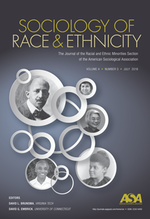
Abstract:
The authors look at how the intersection of gender and race influences pre-tenure faculty members’ perceptions of the clarity of tenure expectations. The authors also seek to identify potential predictors (assessment of mentoring, relationships with peers, feedback on progress toward tenure, and fairness in tenure decision making and evaluation) of perceptions of tenure clarity for four intersectionally defined groups, including historically underrepresented minority women (URMW). The authors use an intersectional perspective and the gendered and racialized organizations’ theoretical lens to interpret the results. The data set comes from the Faculty Job Satisfaction Survey. Findings show that compared with white men, URMW are less satisfied with their relationships with peers and with the fairness in the evaluation of their work. They are also less likely to agree that mentoring is effective, that tenure decisions are fair, and that messages about tenure are consistent.Benchmark Best Practices: Tenure and Promotion
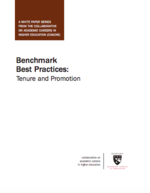
Abstract:
The COACHE surveys of college faculty produce data that are both salient to full-time college faculty and actionable by academic leaders. The survey items are aggregated into 20 benchmarks representing the general thrust of faculty satisfaction along key themes. This white paper discusses the themes of tenure policies, tenure clarity, and promotion.
Administrators and faculty alike acknowledge that, at most institutions, the bar to achieve tenure has risen over time. While it is impossible to eliminate anxiety from the minds of all pre-tenure faculty members, or the pressures exerted on their lives en route to tenure, academic leaders can improve the clarity of tenure policies and expectations without sacrificing rigor. And while the academy has recently improved many policies for assistant professors (e.g., research leave; stop-the-tenure-clock; part-time tenure-track options), it has done far less for associate professors. Ideas have emerged from COACHE research on tenured faculty.
Perspectives on Midcareer Faculty and Advice for Supporting Them
Citation:
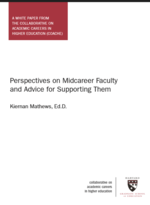
Abstract:
This 8-page white paper was produced for an invited presentation at the Association of Public Land-grant Universities' (APLU) Council on Academic Affairs Summer Meeting in Santa Fe, New Mexico. The paper examines the experiences of midcareer faculty, who face an increased teaching load, greater expectations for service and advising, a more competitive market for grants, and the disappearance of mentoring programs that supported them as early-career faculty. The toll of these obligations is heavier on women and faculty of color. Institutions can address the challenges midcareer faculty face by designing orientations that cover the entire career, implementing career re-visioning programs, providing opportunities for re-engagement, and mentoring associate professors.Recognizing Faculty with Disabilities: Data and Considerations from the Faculty Job Satisfaction Survey
Citation:
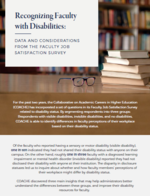
Abstract:
In 2019, COACHE added a series of questions about disability status to our flagship Faculty Job Satisfaction Survey. Two years of data were examined to understand how faculty's experience of the academic workplace might vary depending on their disability type and disclosure status. Review the infographic below to understand how attitudes and disclosure differ across types of disabilities and how administration can create inclusive policies to address these key insights. Click here for an accessible version of the document.Assessing the Needs of Part-Time Faculty: Lessons Learned from the University at Buffalo
Citation:
Abstract:
According to the American Association of University Professors (AAUP), approximately 40% of all faculty across all institutional types are now part-time. This subset of adjunct faculty is fulfilling a critical role in the higher education landscape, yet the variability of these appointments makes it exceedingly difficult to assess their needs and, ultimately, provide adequate support.
In 2017, COACHE partners at the University at Buffalo set out to address this knowledge gap by adapting the Faculty Job Satisfaction Survey to suit the needs of their part-time faculty. In this webinar, Robert Granfield and Tilman Baumstark will share the challenges faced and lessons learned, both from their methodology and from their faculty, throughout this endeavor.
Does the environment matter? Faculty satisfaction at 4-year colleges and universities in the USA
Citation:

Abstract:
Faculty members seek employment in an environment that offers good fit and work satisfaction. This study examined faculty satisfaction by institution type (baccalaureate, master’s, doctoral, and research) for recent full-time faculty members in 100 4-year institutions in the United States.
Analysis of the Faculty Job Satisfaction Survey showed that respondents in baccalaureate colleges reported the highest satisfaction. Subsequent analyses to examine strength of difference across institutional type confirmed initial differences for some facets of satisfaction, but not for others. Results showed that faculty perceptions of the institutional environment firmly contribute to their satisfaction. The authors discuss the implications of their findings for policies and programs.
Success on the Tenure Track: Five Keys to Faculty Job Satisfaction
Citation:
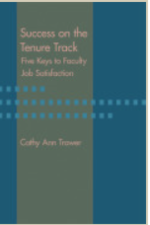
Abstract:
Landing a tenure-track position is no easy task. Achieving tenure is even more difficult. Under what policies and practices do faculty find greater clarity about tenure and experience higher levels of job satisfaction? What makes an institution a great place to work?
In 2005–2006, the Collaborative on Academic Careers in Higher Education surveyed more than 15,000 tenure-track faculty at 200 institutions. The survey was designed around five key themes: tenure clarity, work-life balance, support for research, collegiality, and leadership.
Success on the Tenure Track positions the survey data in the context of actual colleges and universities. Best practices at the highest-rated institutions in the survey—Auburn, Ohio State, North Carolina State, Illinois at Urbana-Champaign, Iowa, Kansas, and North Carolina at Pembroke—give administrators practical, proven advice on increasing employee satisfaction. Additional chapters discuss faculty demographics, trends in employment practices, creating a great workplace for faculty, and the future of tenure.
Data, Leadership, and Catalyzing Culture Change
Citation:

Abstract:
As the national economy has worsened, a large cadre of tenured senior faculty is graying and staying at their institutions. This has left an older set of full professors who began their careers in a different era, an overworked and underappreciated set of associate professors, and a group of assistant professors who are wondering, “What have I gotten myself into?”
By and large, tenure-track faculty want what they have always wanted: clear and reasonable tenure requirements; support for teaching and research; an environment that allows them to juggle responsibilities at work and home; and a set of colleagues to whom they can turn for mentoring, collaborations, intellectual stimulation, and friendship. But several differences between the past and present affect these faculty dramatically.
A New Generation of Faculty: Similar Core Values in a Different World
Citation:
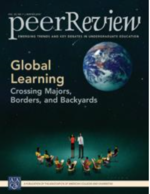
Abstract:
While tenure-track faculty may want the same things as their predecessors, younger Boomers (born 1956-1963) and Gen X faculty live and work in a very different world than older Boomers (born 1946-1955) and Traditionalists (born before 1946). Because of this, Gen Xers, in particular, have been vocal about wanting increased flexibility, greater integration of their work and home lives, more transparency of tenure and promotion processes, a more welcoming, diverse, and supportive workplace/department, and more frequent and helpful feedback about progress.
Faculty Departure and Retention at Small Liberal Arts Colleges
Citation:
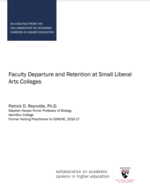
Abstract:
Voluntary faculty departures can often be prevented, but a lack of common exit procedures have hindered institutions’ ability to create proactive practices of faculty retention and instead harbor reactive tendencies with little positive outcome. Through interviews with 22 CAOs at liberal arts colleges, Patrick D. Reynolds, former Visiting Practitioner to COACHE, discovered partner employment and career choice were the two most prominent reasons for departures. Outliers also revealed that work and social environments, especially for faculty members of minority groups, often played a role in dissatisfaction.
Success After Tenure: Lessons in Engaging Midcareer Faculty
Citation:
Abstract:
Mid-career faculty actively seek professional satisfaction and personal well-being in their careers at the departmental and institutional level. However, a growing body of research tells us that the policies and practices in place at colleges and universities do not always support this goal. This webinar, “Success After Tenure: Lessons in Engaging Mid-Career Faculty,” offers an inside take on the themes of the book Success After Tenure: Supporting Mid-Career Faculty and provide real-world best practices from practitioners in the field.
Full Text
Watch the Recording
Download the presentation slides
Building a Better Exit Study: A National Effort to Understand Faculty Retention & Turnover
Citation:
Abstract:
In 2016, COACHE partnered with the University of California System to pilot our newest undertaking -- the Faculty Retenion and Exit Survey. This survey is the only multi-institutional study of faculty retention and exit, and examines the costs, conduct, and causes of faculty turnover.
In this webinar, Kiernan Mathews and Todd Benson describe how the survey came to be, and outline some of the initial findings from the pilot study along with some practical recommendations for Academic Affairs administrators.
Correlates of Work-Life Balance for Faculty Across Racial/Ethnic Groups
Citation:
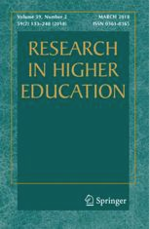
Abstract:
Very few studies have examined issues of work-life balance among faculty of different racial/ethnic backgrounds. Utilizing data from the Faculty Job Satisfaction Survey, this study examined predictors of work-life balance for 2,953 faculty members from 69 institutions. The predictors of work-life balance included faculty characteristics, departmental/institutional characteristics and support, and faculty satisfaction with work. While African American women faculty reported less work-life balance than African American men, the reverse was true for Latina/o faculty. In addition, White faculty who were single with no children were significantly less likely to report having work-life balance than their married counterparts with children. Faculty rank was a significant positive predictor of work-life balance for all faculty. Notably, the findings highlight the importance of department and institutional support for making personal/family obligations and an academic career compatible. In addition, satisfaction with time spent on research had positive associations with work-life balance for all faculty.
Reasonableness and clarity of tenure expectations: Gender and race differences in faculty perceptions.
Citation:
Abstract:
This dissertation studies how higher education policies and practices can affect faculty retention and proposes changes that higher education institutions need to make to retain their faculty. The first manuscript investigates the reasonableness of tenure expectations as it relates to work-life balance, the second explores whether women’s and men’s assessments of tenure-related departmental practices influence their perceptions of clarity of tenure expectations, and the third looks at how the intersection of gender and race influences faculty perceptions of clarity of tenure expectations. The dissertation uses Faculty Job Satisfaction Survey data from a sample of 2,438 tenure-track assistant professors at research universities.
Understanding the changing faculty workforce in higher education: A comparison of non-tenure track and tenure line experiences
Citation:

Abstract:
Non-tenure track faculty are a growing majority in American higher education, but research examining their work lives is limited. Moreover, the theoretical frameworks commonly used by scholars have been critiqued for reliance on ideologically charged assumptions. Using a conceptual model developed from Hackman and Oldham’s (1980) Job Characteristics Model (JCM) and prior research on faculty workplace experiences, this study considers the extent to which full-time non-tenure track and tenure line faculty share a professionalized approach to their jobs, working conditions, and how this is associated with their organizational commitment.
Satisfaction with resources, rewards, autonomy and feedback had a significant positive relationship with odds of organizational commitment for all faculty groups. Overall, the results suggest being removed from the tenure track is not associated with faculty viewing their jobs in a substantially different way than those in tenure line positions, which underscores the importance of conceptualizing full-time faculty work as an integrated whole.
The Art of Diversity: A Chronicle of Advancing the University of California Faculty through Efforts in Diversity, Equity, and Inclusion, 2010–2022
Citation:
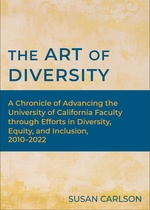
Abstract:
In The Art of Diversity: A Chronicle of Advancing the University of California Faculty through Efforts in Diversity, Equity, and Inclusion, 2010–2022, Susan Carlson details the University of California’s systemwide efforts to increase the diversity of its faculty during her tenure as Vice Provost, UC Office of the President. It tells the story of a remarkable alignment of California stakeholders—from the UC Regents and University leaders to the Academic Senate and the California legislature, from small faculty teams to multicampus coalitions—and how they worked to create a 21st-century faculty that reflects the diversity of California. This chronicle’s central focus is on a community of practice dedicated to excellence and equity. Efforts began with a program focused on finding new ways to collect data on faculty recruitment and create multicampus discussions on key topics like mentoring, intersectional racial and gender identities, workplace climate, and statements on diversity, equity, and inclusion. These efforts continued with a novel interactive theater program for department chairs and deans. The capstone effort, Advancing Faculty Diversity, provides opportunities to pilot new ways to recruit and sustain inclusive and equitable academic communities.
Carlson addresses this central academic issue: how to build a faculty that is different from the past not only in its gender and racial makeup, but also in its research methodologies, transdisciplinary partnerships, and multimodal pedagogies.
Cross-cultural mentoring in higher education: the use of a cultural identity development model
Citation:
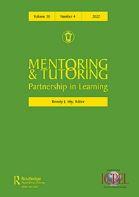
Abstract:
This article examines the role that cultural identity development plays in understanding cross-cultural mentoring encounters between White faculty and faculty of color. The authors present the components of a conceptual framework for developing mentoring approaches that consider a person’s cultural identity stage of development. Using a systematic approach, the authors consider the fundamental principles of cultural identity development theory combined with higher education contextual conditions, resulting in an approach by which mentors and protégés could govern their interactions. The article concludes with implications for mentoring program administrators, faculty, and leaders in higher education.Clear as Mud: Promotion Clarity by Gender and BIPOC Status Across the Associate Professor Lifespan
Citation:
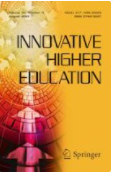
Abstract:
Mid-career faculty members often seek to advance to the highest faculty rank of full professor, but research suggests women and Black, Indigenous and Other People of Color (BIPOC) faculty face inequitable patterns in advancement to the full professor rank. This study focuses on associate professors’ perceptions of promotion clarity, or the degree to which they are clear about the processes and criteria for advancing to the full professor rank.- 1 of 8
- »
Browse Resources by Faculty Type
Job Satisfaction Among Nursing Faculty in Canada and the United States
Citation:
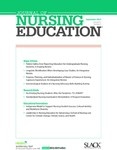
Abstract:
Higher education wants a satisfied workforce to ensure the organization reaches their stated or evolving goals; however, if faculty are dissatisfied, there can be harmful and long-term consequences on productivity and organizational outcome. This study examined nursing faculty's job satisfaction and intent to stay in universities in the United States and Canada.Women Faculty in STEM Disciplines: Experiences with the Tenure Process and Departmental Practices
Citation:
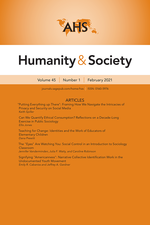
Abstract:
Using Faculty Job Satisfaction Survey data, the purpose of the study is to explore predictors of perceptions of tenure clarity for faculty in STEM and non-STEM fields. We use the gendered organization framework to examine whether for four groups of faculty (women and men in STEM and women and men in non-STEM), assessment of fairness in tenure decisions and evaluations, messages about tenure requirements, mentoring, and relationships with peers have a similar effect on their assessment of tenure clarity. Women in STEM fields are less likely to perceive the expectations for tenure as clear or to assess tenure decisions and evaluations as fair, mentoring as effective, and relationships with peers as satisfactory.College nursing faculty job satisfaction and retention: A national perspective
Citation:
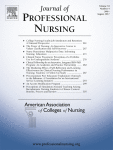
Abstract:
The need for registered nurses in the United States continues to grow. To meet this need for increased numbers of nurses, recruitment and retention of qualified nurse educators has become a priority, and job satisfaction and nursing faculties’ intent to stay have emerged as important considerations for administrators.
The purpose of this study is to analyze variables of relationships with nurse faculty job satisfaction and intent to stay from data collected throughout the United States. The Faculty Job Satisfaction Survey was employed for the purposes of this study. Over 1,350 nurse educators were included in the survey. The findings support a variety of modifiable variables that are viewed as important by nursing faculty. The strongest relationship was found to be institutional leadership. The implications can inform academic administrators seeking to retain nursing faculty.
- 1 of 2
- »
Gender and Race Differences in Faculty Assessment of Tenure Clarity: The Influence of Departmental Relationships and Practices
Citation:

Abstract:
The authors look at how the intersection of gender and race influences pre-tenure faculty members’ perceptions of the clarity of tenure expectations. The authors also seek to identify potential predictors (assessment of mentoring, relationships with peers, feedback on progress toward tenure, and fairness in tenure decision making and evaluation) of perceptions of tenure clarity for four intersectionally defined groups, including historically underrepresented minority women (URMW). The authors use an intersectional perspective and the gendered and racialized organizations’ theoretical lens to interpret the results. The data set comes from the Faculty Job Satisfaction Survey. Findings show that compared with white men, URMW are less satisfied with their relationships with peers and with the fairness in the evaluation of their work. They are also less likely to agree that mentoring is effective, that tenure decisions are fair, and that messages about tenure are consistent.Reasonableness and clarity of tenure expectations: Gender and race differences in faculty perceptions.
Citation:
Abstract:
This dissertation studies how higher education policies and practices can affect faculty retention and proposes changes that higher education institutions need to make to retain their faculty. The first manuscript investigates the reasonableness of tenure expectations as it relates to work-life balance, the second explores whether women’s and men’s assessments of tenure-related departmental practices influence their perceptions of clarity of tenure expectations, and the third looks at how the intersection of gender and race influences faculty perceptions of clarity of tenure expectations. The dissertation uses Faculty Job Satisfaction Survey data from a sample of 2,438 tenure-track assistant professors at research universities.
Examining faculty satisfaction, productivity, and collegiality in higher education: Contemporary contexts and modern methods
Citation:
Thesis Type:
DissertationAbstract:
In response to discourse surrounding faculty accountability and diversity, this dissertation describes three studies of faculty satisfaction, productivity, and collegiality in higher education. The studies employed advanced quantitative methods to analyze and interpret faculty data at four-year colleges and universities.
The first study revealed a strong, positive, and highly significant relationship between campus racial climate and faculty satisfaction at the individual level, regardless of gender, race/ethnicity, and tenure status. The second study identified five classes of faculty productivity with respect to gender, race, institutional type, and levels of faculty satisfaction.
The third study examined the relationships among faculty collegiality, job satisfaction, and turnover intentions. Significant findings indicated that faculty collegiality was strongly and positively related to job satisfaction and negatively related to turnover intentions, regardless of gender and race/ethnicity. Women faculty and faculty of color indicated lower levels of collegiality, and faculty of color reported lower job satisfaction and higher turnover intentions.
The Situational Context of Tenured Female Faculty in the Academy and the Impact of Critical Mass of Tenured Female Faculty on Pre-tenure Faculty Job Satisfaction: A Four Discipline Study
Citation:
Thesis Type:
DissertationAbstract:
This research studies the convergence between critical mass, discipline and gender in the academy. Critical mass theory is based on the concept that when a "nonmajority" group reaches a minimal threshold they can generate lasting change within an organization. While women receive doctoral degrees in higher percentages than their male colleagues, they do not ascend the ranks in the same proportions (Touchton, McTighe Musil, & Peltier Campbell, 2008). A critical mass of tenured female faculty has the ability to positively impact the environment for pre-tenure faculty at the departmental level.
The study used data from the 2011-12 COACHE survey of faculty in finance/accounting, management, English and history. A critical mass of tenured female faculty positively impacted environments for pre-tenure females and males in history and females in management. In management departments without a critical mass of tenured female faculty, females were significantly less satisfied while their male colleagues were significantly more satisfied. Further qualitative research is needed to better understand environments using the lenses of critical mass, discipline and gender.
The role of citizenship status in intent to leave for pre-tenure faculty
Citation:
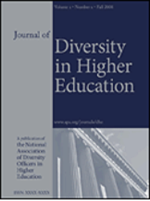
Abstract:
Using a national database, this study uses discriminant analysis to explore the role of citizenship status in determining intent to leave for pre-tenure faculty members at 4-year research universities. Of the three possible responses (intend to stay, intend to leave, and undecided), two functions emerged. The first function differentiates those who intend to stay from those who intend to leave and those who are undecided. The second function differentiates between those who intend to leave and those who are undecided.
Measures of satisfaction with workplace serve as the primary indicators of function one. Race and citizenship status are the only variables significant for function two. Demographic variables, discipline, salary, and institutional variables are not significant in either function. The variables that are significant for the entire sample are similar to those significant just for non-U.S. citizen faculty. Implications of this study for institutions include attending to departmental and institutional fit, recognition of diversity among non-U.S. citizen faculty, and working toward improving various components of satisfaction.
Success on the Tenure Track: Five Keys to Faculty Job Satisfaction
Citation:

Abstract:
Landing a tenure-track position is no easy task. Achieving tenure is even more difficult. Under what policies and practices do faculty find greater clarity about tenure and experience higher levels of job satisfaction? What makes an institution a great place to work?
In 2005–2006, the Collaborative on Academic Careers in Higher Education surveyed more than 15,000 tenure-track faculty at 200 institutions. The survey was designed around five key themes: tenure clarity, work-life balance, support for research, collegiality, and leadership.
Success on the Tenure Track positions the survey data in the context of actual colleges and universities. Best practices at the highest-rated institutions in the survey—Auburn, Ohio State, North Carolina State, Illinois at Urbana-Champaign, Iowa, Kansas, and North Carolina at Pembroke—give administrators practical, proven advice on increasing employee satisfaction. Additional chapters discuss faculty demographics, trends in employment practices, creating a great workplace for faculty, and the future of tenure.
Perspectives on Midcareer Faculty and Advice for Supporting Them
Citation:

Abstract:
This 8-page white paper was produced for an invited presentation at the Association of Public Land-grant Universities' (APLU) Council on Academic Affairs Summer Meeting in Santa Fe, New Mexico. The paper examines the experiences of midcareer faculty, who face an increased teaching load, greater expectations for service and advising, a more competitive market for grants, and the disappearance of mentoring programs that supported them as early-career faculty. The toll of these obligations is heavier on women and faculty of color. Institutions can address the challenges midcareer faculty face by designing orientations that cover the entire career, implementing career re-visioning programs, providing opportunities for re-engagement, and mentoring associate professors.The workplace satisfaction of newly-tenured faculty members at research universities
Citation:
Thesis Type:
DissertationAbstract:
If faculty are dissatisfied with their work, colleges and universities can experience educational and organizational repercussions that include contentious departmental climates and stagnant work productivity. The dissatisfaction of newly tenured faculty, who face unique transitional circumstances, could have particularly negative consequences.
This dissertation uses Faculty Job Satisfaction Survey data, along with interviews of 12 newly tenured faculty members, to estimate the predictors of newly tenured faculty workplace satisfaction. The results indicate that newly-tenured faculty tend to be satisfied with their institutions when they have communicative senior leaders, fair and reasonable compensation, and a sense of belonging in their departments. At the departmental level, newly-tenured faculty are more likely to be satisfied when norms and behaviors promote inclusion and diversity, colleagues are respectful, and departmental leaders are supportive. The results of this study can stimulate thinking about new policies and practices to maximize the satisfaction and performance of faculty during this transformative period in their careers.
Data, Leadership, and Catalyzing Culture Change
Citation:

Abstract:
As the national economy has worsened, a large cadre of tenured senior faculty is graying and staying at their institutions. This has left an older set of full professors who began their careers in a different era, an overworked and underappreciated set of associate professors, and a group of assistant professors who are wondering, “What have I gotten myself into?”
By and large, tenure-track faculty want what they have always wanted: clear and reasonable tenure requirements; support for teaching and research; an environment that allows them to juggle responsibilities at work and home; and a set of colleagues to whom they can turn for mentoring, collaborations, intellectual stimulation, and friendship. But several differences between the past and present affect these faculty dramatically.
Clear as Mud: Promotion Clarity by Gender and BIPOC Status Across the Associate Professor Lifespan
Citation:

Abstract:
Mid-career faculty members often seek to advance to the highest faculty rank of full professor, but research suggests women and Black, Indigenous and Other People of Color (BIPOC) faculty face inequitable patterns in advancement to the full professor rank. This study focuses on associate professors’ perceptions of promotion clarity, or the degree to which they are clear about the processes and criteria for advancing to the full professor rank.Women Faculty in STEM Disciplines: Experiences with the Tenure Process and Departmental Practices
Citation:

Abstract:
Using Faculty Job Satisfaction Survey data, the purpose of the study is to explore predictors of perceptions of tenure clarity for faculty in STEM and non-STEM fields. We use the gendered organization framework to examine whether for four groups of faculty (women and men in STEM and women and men in non-STEM), assessment of fairness in tenure decisions and evaluations, messages about tenure requirements, mentoring, and relationships with peers have a similar effect on their assessment of tenure clarity. Women in STEM fields are less likely to perceive the expectations for tenure as clear or to assess tenure decisions and evaluations as fair, mentoring as effective, and relationships with peers as satisfactory.Work–Family Balance and Tenure Reasonableness: Gender Differences in Faculty Assessment
Citation:
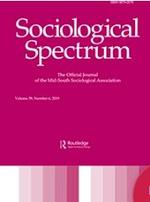
Abstract:
Perceptions of work–family balance and of the reasonableness of tenure expectations are key faculty retention factors. Using the Faculty Job Satisfaction Survey, which includes data from 2,438 tenure-track assistant professors, Rodica Lisnic, Anna Zajicek, and Brinck Kerr explore whether faculty assessment of departmental and institutional support for family influences their perceptions of the reasonableness of tenure expectations.
Results reveal that women are less likely than men to report tenure expectations as scholars are reasonable and that departments and institutions are supportive of family-work balance. Departmental support for family-work balance, caring for an ill family member, satisfaction with family-friendly policies, and workload have the strongest association with reasonableness. Satisfaction with family-friendly policies has a significant relationship with reasonableness of tenure expectations only for faculty with family care responsibilities. These results have implications for family-friendly policies and practices in academia.
- 1 of 5
- »
Browse Resources by Type
- Infographics
- Partner Case Studies
- Publications using COACHE data
- Statistical Reports
- Webinars
- Whitepapers
- Year in Review
2019 Year in Review: The Collaborative on Academic Careers in Higher Education
Citation:
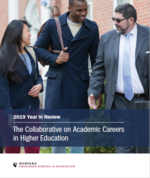
Abstract:
COACHE’s 2019 work focused on two types of faculty members: those who leave and those who lead. This work incorporated a larger number of faculty members than in 2018, with 41 colleges, universities, and specialized programs in the 2019 Faculty Job Satisfaction Survey cohort, a total of more than 28,000 faculty participants, and an average institutional response rate of 54 percent.
Institutional reports for the Faculty Retention and Exit Survey indicate why faculty leave—or remain—at their institutions, and where inequities arise in retention negotiations. COACHE’s work also examined how we define faculty leadership, and which faculty leaders—women and humanities faculty among them—are less likely to receive institutional support in sustaining other aspects of their work.
2018 Year in Review: The Collaborative on Academic Careers in Higher Education
Citation:
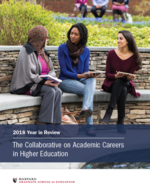
Abstract:
In 2018, the Collaborative on Academic Careers in Higher Education collaborated with the Harvard Institutes for Higher Education (HIHE) to launch the first ever Seminar on Leadership of the Faculty, a three-day workshop for academic leadership. An introduction between Harvard Club of New York, HIHE, and COACHE partners in the CUNY system led to a $100,000 grant for CUNY to invest in developing diverse faculty leadership. Data from the Faculty Job Satisfaction Survey yielded an exploration of mid-career faculty, an ongoing pursuit to prevent mid-career malaise and provide support. The Faculty Retention and Exit Survey revealed the risk that a “counteroffer culture” poses to faculties’ home institutions during salary negotiations. Finally, an overhaul of our data dissemination process has made it easier for researchers to access our data in order to implement institutional changes.
2017 Year in Review: The Collaborative on Academic Careers in Higher Education
Citation:
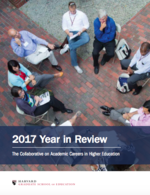
Abstract:
In the 2016-2017 academic year, the Collaborative welcomed our largest and most diverse cohort of Faculty Job Satisfaction partners to date with over 60 higher education institutions—public and private, two- and four-year—joining our ranks. After a successful pilot, we launched the first ever multi-institutional study of Faculty Retention and Exit to 12 institutions nationwide in the spring and 22 in the fall. And to complement our survey offerings, we adapted our reporting platform to be more robust than ever, with additional race and ethnicity categories and academic area analyses.
Recognizing Faculty with Disabilities: Data and Considerations from the Faculty Job Satisfaction Survey
Citation:

Abstract:
In 2019, COACHE added a series of questions about disability status to our flagship Faculty Job Satisfaction Survey. Two years of data were examined to understand how faculty's experience of the academic workplace might vary depending on their disability type and disclosure status. Review the infographic below to understand how attitudes and disclosure differ across types of disabilities and how administration can create inclusive policies to address these key insights. Click here for an accessible version of the document.Revealing Data on Faculty Retention & Departure
Citation:
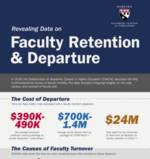
Abstract:
In 2017, after a successful pilot with several campuses of a large public university system, COACHE launched the Faculty Retention and Exit Survey nationwide. This study represents the first multi-institutional survey of faculty retentions (among those with outside offers) and departures. Until now, there was no coordinated effort for universities to develop a common understanding of the causes, costs, and conduct of faculty mobility.
Among the takeaways: More than half of faculty ranked salary as a secondary factor or not a factor in their decision to stay or leave. But 67% selected quality of colleagues as a compelling factor. The study also found that faculty are expected to cultivate outside offers before they can ask for a better deal at home, and that this requirement pushes them out the door: nearly 1 in 3 faculty who left originally sought the offer only to renegotiate the terms of their employment.
Full Text

Using the Faculty Job Satisfaction Survey to Improve Equity for Texas Tech Faculty
Citation:
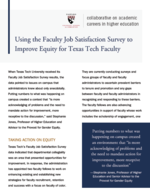
Abstract:
Upon receiving their Faculty Job Satisfaction Survey results, Texas Tech University set to work addressing some of the equity gaps brought to light. Among their priorities was departmental collegiality, diversity and equity across divisions, and department chair training. By creating two faculty fellow positions and a team Faculty Equity Advocates, Texas Tech is set to make meaningful changes on their campus.Tailoring a Survey for Campus Change at the University of Denver
Citation:
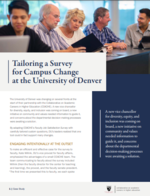
Abstract:
The University of Denver was changing on several fronts at the start of their partnership with the Collaborative on Academic Careers in Higher Education (COACHE). A new vice chancellor for diversity, equity, and inclusion was coming on board, a new initiative on community and values needed information to guide it, and concerns about the departmental decision-making processes were awaiting a solution.
By adapting COACHE’s Faculty Job Satisfaction Survey with carefully tailored custom questions, DU’s leaders realized that one tool could in fact support many changes.
Building Trust, Engaging Faculty, Taking Action: Supporting the Next Generation of Faculty at Georgia State University
Citation:
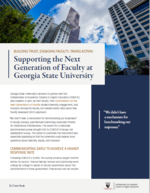
Abstract:
Georgia State University decided to partner with COACHE after the university’s Commission on the Next Generation of Faculty urged the institution to gather more robust data on diversity, equity, and inclusion on campus. The provost’s office made three guarantees to faculty about the Faculty Job Satisfaction Survey: the administration wanted to hear from every full-time faculty member, they would not receive data that would allow them to identify any individual faculty member, and they would use the results for campus improvement. This transparancy has already borne fruit. With a higher response rate than peer institutions and a renewed sense of trust, GSU administrators are moving forward in unpacking the results collaboratively with their faculty.- 1 of 2
- »
The Art of Diversity: A Chronicle of Advancing the University of California Faculty through Efforts in Diversity, Equity, and Inclusion, 2010–2022
Citation:

Abstract:
In The Art of Diversity: A Chronicle of Advancing the University of California Faculty through Efforts in Diversity, Equity, and Inclusion, 2010–2022, Susan Carlson details the University of California’s systemwide efforts to increase the diversity of its faculty during her tenure as Vice Provost, UC Office of the President. It tells the story of a remarkable alignment of California stakeholders—from the UC Regents and University leaders to the Academic Senate and the California legislature, from small faculty teams to multicampus coalitions—and how they worked to create a 21st-century faculty that reflects the diversity of California. This chronicle’s central focus is on a community of practice dedicated to excellence and equity. Efforts began with a program focused on finding new ways to collect data on faculty recruitment and create multicampus discussions on key topics like mentoring, intersectional racial and gender identities, workplace climate, and statements on diversity, equity, and inclusion. These efforts continued with a novel interactive theater program for department chairs and deans. The capstone effort, Advancing Faculty Diversity, provides opportunities to pilot new ways to recruit and sustain inclusive and equitable academic communities.
Carlson addresses this central academic issue: how to build a faculty that is different from the past not only in its gender and racial makeup, but also in its research methodologies, transdisciplinary partnerships, and multimodal pedagogies.
Job Satisfaction Among Nursing Faculty in Canada and the United States
Citation:

Abstract:
Higher education wants a satisfied workforce to ensure the organization reaches their stated or evolving goals; however, if faculty are dissatisfied, there can be harmful and long-term consequences on productivity and organizational outcome. This study examined nursing faculty's job satisfaction and intent to stay in universities in the United States and Canada.Cross-cultural mentoring in higher education: the use of a cultural identity development model
Citation:

Abstract:
This article examines the role that cultural identity development plays in understanding cross-cultural mentoring encounters between White faculty and faculty of color. The authors present the components of a conceptual framework for developing mentoring approaches that consider a person’s cultural identity stage of development. Using a systematic approach, the authors consider the fundamental principles of cultural identity development theory combined with higher education contextual conditions, resulting in an approach by which mentors and protégés could govern their interactions. The article concludes with implications for mentoring program administrators, faculty, and leaders in higher education.- 1 of 18
- »
COVID-19 Impact Study: Technical Report
Citation:
Abstract:
The findings from a series of statistical analyses present compelling evidence that the disruption to campus operations caused by the coronavirus (COVID-19) in March 2020 impacted faculty perceptions of some aspects of their campus environment. This impact was felt across all institutions that participated in the COACHE Faculty Job Satisfaction Survey (JSAT) for a subset of JSAT benchmarks and specific items. At the same time, some benchmarks and most items were unaffected. The majority of the benchmarks and items that were impacted concerned leadership, governance, and decision-making. Additional analyses of the differences between benchmark scores with and without the presence of post-disruption responses suggest that the degree of change with the inclusion of post-disruption responses is negligible in practical application and does not warrant additional data cleaning for valid interpretation of report findings.Selected Dimensions of the Faculty Workplace Experience
Citation:
Abstract:
In conjunction with the AAC&U Annual Meeting, COACHE is providing access to digital spreadsheets summarizing results from its Faculty Job Satisfaction Survey, including responses from approximately 43,000 faculty at 2- and 4-year colleges and universities. COACHE Summary Tables 2019 provides responses organized by major Carnegie Classification and disciplinary groups, then by faculty rank (and tenure status), race/ethnicity, or gender. The following tables were extracted from COACHE Summary Tables 2019 for use in our discussion.COACHE Summary Tables 2019: Selected Dimensions of the Faculty Workplace Experience
Citation:
Abstract:
These summary tables include data from the 2019 Faculty Job Satisfaction Survey, focusing on the faculty workplace experience, with data presented by institution type, discipline, rank (with tenure status), race/ethnicity, and gender. Survey dimensions shown in the summary tables include questions about the nature of faculty work, facilities and family resources, interdisciplinary work, tenure clarity, promotion, and shared governance.Full Text
Access the 2019 summary tables
- 1 of 3
- »
Examining the Impacts of COVID-19 on Faculty Retention & Exit
Citation:
Abstract:
For the last five years, the Collaborative on Academic Careers in Higher Education (COACHE) has been conducting the Faculty Retention and Exit Survey to gain a deeper understanding of the academic work environment by examining faculty mobility. In spring 2020, we added three COVID-19-related questions to the survey to capture the early effects of the pandemic.
In this webinar, Doctoral Fellow, Mai H. Vang, presents findings from the responses to those questions, which captured nine themes, including disruption of research, disconnection due to remote work, and inequities in the pandemic’s impact on particular faculty.
Download the full report of our findings and presentation slides
Full Text
Assessing the Needs of Part-Time Faculty: Lessons Learned from the University at Buffalo
Citation:
Abstract:
According to the American Association of University Professors (AAUP), approximately 40% of all faculty across all institutional types are now part-time. This subset of adjunct faculty is fulfilling a critical role in the higher education landscape, yet the variability of these appointments makes it exceedingly difficult to assess their needs and, ultimately, provide adequate support.
In 2017, COACHE partners at the University at Buffalo set out to address this knowledge gap by adapting the Faculty Job Satisfaction Survey to suit the needs of their part-time faculty. In this webinar, Robert Granfield and Tilman Baumstark will share the challenges faced and lessons learned, both from their methodology and from their faculty, throughout this endeavor.
Success After Tenure: Lessons in Engaging Midcareer Faculty
Citation:
Abstract:
Mid-career faculty actively seek professional satisfaction and personal well-being in their careers at the departmental and institutional level. However, a growing body of research tells us that the policies and practices in place at colleges and universities do not always support this goal. This webinar, “Success After Tenure: Lessons in Engaging Mid-Career Faculty,” offers an inside take on the themes of the book Success After Tenure: Supporting Mid-Career Faculty and provide real-world best practices from practitioners in the field.
Full Text
Watch the Recording
Download the presentation slides
- 1 of 2
- »
Benchmark Best Practices: Mentoring
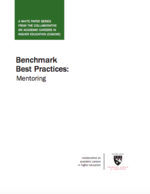
Abstract:
The COACHE surveys of college faculty produce data that are both salient to full-time college faculty and actionable by academic leaders. The survey items are aggregated into 20 benchmarks representing faculty satisfaction. This white paper examines the effectiveness of mentoring within departments, outside departments but at the same institution, and outside the institution.
Mentoring has always been important in the academic workplace. Only in recent years, however, has the practice evolved more widely from incidental to intentional as academic leaders have come to appreciate that mentorship is too valuable to be left to chance.
Many pre-tenure faculty members feel mentoring is essential to their success, but such support is also instrumental for associate professors on their path to promotion. While some institutions rely on the mentor-protégé approach (a senior faculty member formally paired with a junior faculty member), new models encourage mutual mentoring, team mentoring, and strategic collaborations beyond the department.
Benchmark Best Practices: Interdisciplinary Work & Collaboration
Citation:
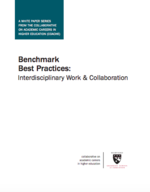
Abstract:
The COACHE surveys of college faculty produce data that are both salient to full-time college faculty and actionable by academic leaders. The survey items are aggregated into 20 benchmarks representing faculty satisfaction. This white paper examines collaboration—within departments, outside of departments but at the same institution, and outside the institution—and attitudes toward interdisciplinary work.
While interest in interdisciplinary work has increased, and this type of work attracts many graduate students and early-career faculty, the academy has not yet fully embraced interdisciplinary work. Unchanged policies, structures and cultures are institutional disincentives, as they are still best-suited to narrower work within disciplines. This includes publication vehicles, multiple authors, peer review, and reward structures.
Benchmark Best Practices: Department Engagement, Quality, and Collegiality
Citation:
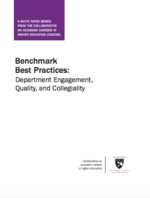
Abstract:
The COACHE surveys of college faculty produce data that are both salient to full-time college faculty and actionable by academic leaders. The survey items are aggregated into 20 benchmarks representing faculty satisfaction. This white paper discusses departmental engagement, quality, and collegiality.
Departmental quality is a function of the intellectual vitality of faculty, the scholarship that is produced, the effectiveness of teaching, how well the department recruits and retains excellent faculty, and whether and how poor faculty performance is handled. While many factors comprise faculty members’ sense of departmental collegiality, COACHE has discovered that faculty are especially cognizant of their “fit” among their colleagues, their personal interactions with colleagues, whether their colleagues “pitch in” when needed, and colleague support for work/life balance. There is no substitute for a collegial department when it comes to faculty satisfaction, and campus leaders—both faculty and administrators—can create opportunities for better informal engagement.

